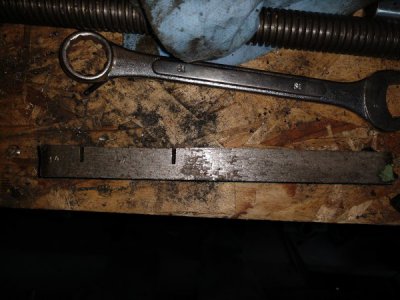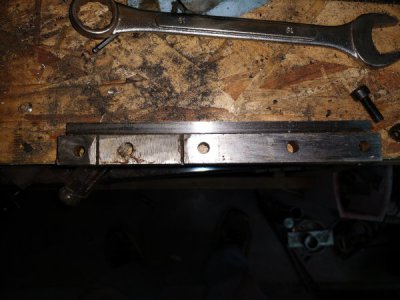After having my lathe for a few years, and just assuming that it never had a carriage lock because there wasn't anything obviously appearing as such, I finally took a look through the manual last night and found that the one odd hex head bolt on the top of the carriage was the saddle lock. Bolt has been tight since the day I got the lathe, and attempting to tighten it any more didn't do anything (I couldn't turn it any tighter without serious force on the wrench).
I've needed to clean the lathe for a while anyways, so I figured this would be a good time to tear it all down. Got the carriage off, pulled off the rails that go under the ways to hold the carriage down (not sure what those rails are called), and found that it looks like someone took a grinder to the section that the carriage lock bolt goes through.
I'm guessing that it shouldn't be like that, but I really don't know as I've never gotten this deep into a lathe before. The lock bolt threads into the portion between the relief cuts, which is also the section that appears have been ground down, and I'm assuming pulls up that one section tight into the ways when locking?

I'm betting this a part that's going to be easily replaced, and I don't have access to precision grinders, so I'm not going to be able to easily replicate this part...perhaps my best bet will be to do some kind of an add-on carriage lock to replace it?
I've needed to clean the lathe for a while anyways, so I figured this would be a good time to tear it all down. Got the carriage off, pulled off the rails that go under the ways to hold the carriage down (not sure what those rails are called), and found that it looks like someone took a grinder to the section that the carriage lock bolt goes through.
I'm guessing that it shouldn't be like that, but I really don't know as I've never gotten this deep into a lathe before. The lock bolt threads into the portion between the relief cuts, which is also the section that appears have been ground down, and I'm assuming pulls up that one section tight into the ways when locking?


I'm betting this a part that's going to be easily replaced, and I don't have access to precision grinders, so I'm not going to be able to easily replicate this part...perhaps my best bet will be to do some kind of an add-on carriage lock to replace it?


